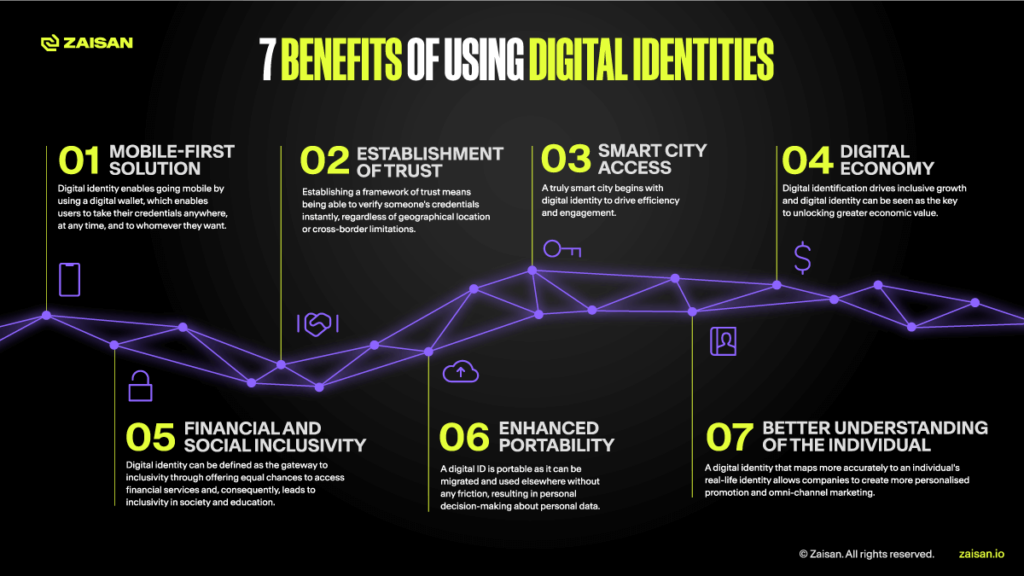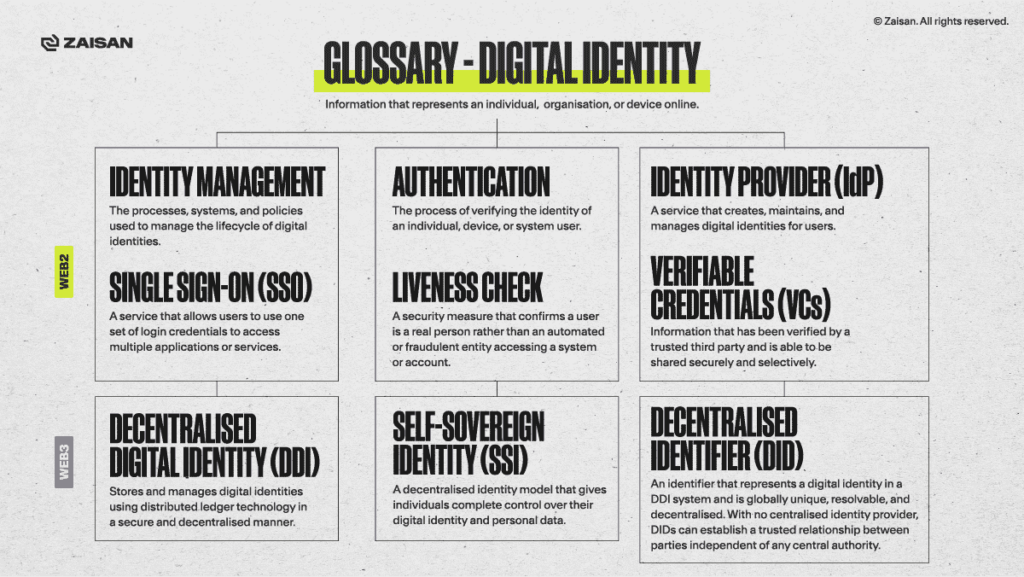There was a time, not so long ago, when someone would have looked perplexed if you’d asked about their digital identity. Many still would today, perhaps but in the tumultuous world of today, digital identity is one of the hottest trends in technology, particularly across decentralised ledgers, or blockchains.
When you think about it, identity is in everything we do. From greeting friends or family to getting a loan from the bank, or purchasing insurance. We take all this for granted. Yet for many millions of people, things aren’t as easy or straightforward when it comes to accessing finance or services. The lack of identity hampers thriving.
The 7 benefits of using digital identities
In short, below are 7 benefits of using digital identities:
• Mobile-first solution
• Establishment of a framework of trust
• Smart city access
• Digital economy
• Financial and social inclusivity
• Enhanced portability
• Better understanding of the individual

Each of these benefits will be explained more in-depth below. But before we delve into the actual benefits of implementing and using digital identity frameworks in both the public and private domains, let’s first take a look at the definition of a digital identity.
In addition, in the final section of this article, we will introduce you the transition of web2 based digital identities to decentralised web3 digital identities.
What is a digital identity?
In essence, a digital identity is the accumulation of information on an entity held online by third parties.
Whenever you are interacting with a website or application you are always leaving information behind. Broadly speaking, all the data and information involved in someone’s digital identity can be divided into two categories: Digital attributes and digital activities.
Digital attributes include someone’s date of birth, official documentation (passports, driver’s license, etc.) serial numbers or other identifiers, a person’s medical records, banking details, etc. The second category -digital activities-, includes a person’s posts on social media, for example, purchase history, ‘Likes’ and comments, etc. The combination of these two categories constitutes someone’s digital identity.
The 7 benefits of using digital identities explained
1. Mobile-first solution
A primitive (but working) handheld mobile phone was unveiled by the now-defunct American company Motorola back in 1973. It was a rather bulky and ungainly device that would take around 10 hours to fully charge. Nevertheless, the Motorola device heralded an inevitable shift toward mobile technology that continues today. (Current projections say that, by 2024, there will be around 17.7 billion mobile devices operating in the world.)
Society is going mobile, and as such, today’s society seeks more and more mobile-first solutions.
Digital identity enables this approach by using a digital wallet that enables users to take their credentials anywhere they go, and share them at any time, with whomever they want, and get authenticated by any entity, private or public, to easily access services.
2. Establishment of a framework of trust
Currently, identity networks and authentication methods are heavily fragmented. Every organisation, every agency, and every institution has its own set of rules and guidelines that determine how people receive their credentials, and how they authenticate in their network. Because of this individualised disparity, a set of credentials accepted by one organisation might not necessarily be accepted by another. This issue is exacerbated when dealing with organisations from different countries. (Driving licenses and educational credentials perfectly illustrate this problem).
Establishing a trust framework between all participating organisations means that someone’s credentials can be instantly verified, regardless of geographical location or cross-border limitations.
3. Smart city access
Current urban enclaves, while modern and relatively safe, are far from smart. There still are many deficiencies and areas of improvement in terms of traffic and waste management, infrastructure, wireless access, etc. The Internet of Things (IoT) will enable several technological advancements that will improve these aspects, but it is a very different story for the individual.
As of today, 54% of the world’s population lives in cities, and the current projection is that this figure will reach 66% in about three decades. Because of this likely rise in urban dwellings, enhanced services, and a positive and rewarding citizen experience are key factors for the success of smart cities. Citizens currently engage with urban’s infrastructures in different ways. Paying for parking or at the shop’s till with a smartphone, for example. Or using electronic tickets to speed up access to trains, buses, or other methods of transportation. But each of these services requires its own identification method. Together with an entire network and technical backend to manage access, permissions, and upkeep.
A truly smart city begins with digital identity to drive engagement and efficiency. Individuals need to engage with government, public and private bodies, and other agencies digitally and expeditiously, so the experience is seamless and positive. This will lead to further engagement.
4. Digital economy
Digital identity truly is at the heart of a paradigm shift in digital engagement. Too much friction in the interaction with governments and service providers holds people back from engaging further, which in turn leads to economic stagnation. In the world of today, people expect fast and immediate digital service, whether it’s from their internet provider or the WiFi service at the airport.
The digital economy is the background for the digital identity scene. Digital identification drives inclusive growth, particularly considering that around 1.7 billion people worldwide are financially excluded. This is because of a lack of provable identity. If all those people were to own digital identities, a great economic value would be unlocked.
5. Financial and social inclusivity
Banks and other financial institutions would not risk lending to those people who could not effectively prove who they are. If credit or finance is denied, the individual might not be able to access proper education, or housing, or services. Progressively, someone would be left further and further behind. They would be excluded.
The provision of identity is the gateway for both financial and social inclusivity. Digital identity enables frictionless interactions with public and private institutions, including banks, of course. By enabling someone to have equal chances to access financial devices, people become included in society or education.
6. Enhanced portability
Traditional means of identification (driver’s licenses, passports, ID cards, etc.) are portable in the sense that people can carry them around. But some of these forms of ID might not be officially recognised in different countries, or even in different states within the same country. Academic credentials have the same issue. And in both cases, the individual depends on third parties to amend, share, or verify some of these documents.
The concept of portability in the context of digital identity applies differently. A digital ID is portable because it can be migrated and used elsewhere without friction, and in a way that is completely up to the individual to make the choices and decisions regarding his personal data.
7. Better understanding of the individual
People are complex entities with changing needs, attitudes, desires, and interests. In today’s always-connected world, commercial enterprises spend a lot of money researching the market to better streamline their product lines and target the right customer segments and demographics.
A digital identity that maps more accurately to an individual’s real-life identity will enable companies to achieve more personalised promotion and more seamless omnichannel marketing.
The transition to web3 digital identities
The introduction of blockchain technology causes a transformation in the future of digital identities. This is often referred to as the transition from web2 to web3. Web3 is characterised by greater decentralisation, as well as empowerment and ownership. Individuals should be in complete control of anything they own online, including personal data, thus reinstating the fairness and equal opportunities that remain elusive for countless people.
In the case of digital identity, a web3 digital identity solution like Zaisan’s allows for more efficient control of who has access to personal data and why.
If you are intrigued by the implications of web3 on the digital identity sector, this article delves into the notion of self-sovereign identity, which serves as the cornerstone of web3 identity solutions.
Below, you will find a glossary that helps clarify the distinctions between Web2 and Web3 digital identities.





